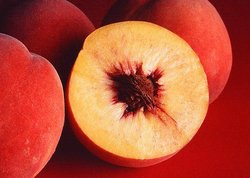Drupe
|
|
In botany, a drupe is a type of fruit in which an outer fleshy part (exocarp or skin and mesocarp or flesh) surrounds a shell (the pit or stone) of hardened endocarp with a seed inside. These fruits develop from a single carpel, and mostly from flowers with superior ovaries. Some flowering plants which produce drupes are:
- coffee
- jujube
- mango
- olive
- avocado
- all members of the genus Prunus, including the almond (in which the mesocarp is somewhat leathery), apricot, cherry, peach, nectarine, and plum.
The term stone fruit can be a synonym for "drupe" or, commonly, it can mean the fruit of the Prunus species specifically.
Drupes, with their sweet, fleshy outer layer, attract the attention of animals as a food, and the plant population benefits from the resulting dispersal of its seeds. The endocarp (pit or stone) is often swallowed, passing through the digestive tract, and returned to the soil in faeces with the seed inside unharmed; sometimes it is dropped after the fleshy part is eaten.
The coconut is also a drupe, but the mesocarp is fibrous or dry (in this case, called a husk), so this type of fruit is classified as a simple dry fruit, fibrous drupe.
Black_Butte_blackberry.jpg
In an aggregate fruit composed of individual small drupes, each individual is called a drupelet. Bramble fruits (such as the blackberry or the raspberry) are aggregates of drupelets.
de:Steinfrucht eo:drupo es:Drupa nl:Steenvrucht sv:Stenfrukt

